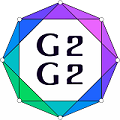Let $G$ be a permutation group on a finite set $\Omega$. Denote the set of orbits of the componentwise action of $G$ on $\Omega^k$ by $\text{Orb}(G,\Omega^k)$. Wielandt [1] defined the $k$-closure of $G$ to be the group
$G^{(k)} = \text{Aut}(\text{Orb}(G,\Omega^k)) = \{g \in \text{Sym}(\Omega) \mid O^g = O~\forall O \in \text{Orb}(G,\Omega^k)\}.$
A permutation group is called...
In this talk we will describe a construction of $2$-PD-sets of $16$ elements for codes from the Desarguesian projective planes $\mathrm{PG}(2,q)$, where $q=2^h$ and $5\leq h \leq 9$. We will also describe a construction of $3$-PD-sets of $75$ elements for the code from the Desarguesian projective plane $\mathrm{PG}(2,q)$, where $q=2^9$. These $2$-PD-sets and $3$-PD-sets can be used for partial...
A Majorana algebra is a commutative nonassociative real algebra generated by a finite set of idempotents, called Majorana axes, that satisfy some of the properties of the $2A$-axes of the Monster Griess algebra. The term was introduced by A. A. Ivanov (2009) inspired by the work of S. Sakuma and M. Miyamoto. In this talk, we are going to revisit, in the context of Majorana theory, the theorem...
Linear codes with complementary duals, shortly named LCD codes, are linear codes whose intersection with their duals is trivial. In this talk, we present a construction for LCD codes over finite fields from the adjacency matrices of two-class association schemes. These schemes consist of either strongly regular graphs (SRGs) or doubly regular tournaments (DRTs).
A $1$-design is weakly $p$-self-orthogonal if all the block intersection numbers gives the same residue modulo $p$. In [1], we analyze extensions of the incidence matrix, orbit matrix and submatrices of orbit matrix of a weakly $p$-self-orthogonal 1-design in order to construct self-orthogonal codes.
A linear codes is called LCD code if the intersection with its dual code is trivial....
A regular graph is semisymmetric if it is edge-transitive but not vertex-transitive. A cubic semisymmetric graph is a 3-regular graph which is semisymmetric. It has been proved that every semisymmetric graph is necessarily bipartite graph. In this talk we study low-density parity-check (LDPC) codes having cubic semisymmetric graphs as their Tanner graphs. We will discuss some of the...
The Yang-Baxter equation first appeared in theoretical physics and statistical mechanics in the works of Yang (1967) and Baxter (1972) and it has led to several interesting applications in different fields of mathematics. For example, the Yang-Baxter equation appears in topology (namely, in knot theory) and algebra since it is strongly connected with braid groups. The problem of studying...
We use mainly standard notation and terminology (see [1]).
Let $G$ be a finite group. Denote by $\pi(G)$ the set of all prime divisors of the order of $G$. If $|\pi(G)| = n$, then $G$ is called $n$-primary.
The Gruenberg--Kegel graph (prime graph) $\Gamma(G)$ of $G$ is a graph with the vertex set $\pi(G)$, in which two distinct vertices $p$ and $q$ are adjacent if and only if there...
In [1], Blokhuis studied maximum cliques in Paley graphs of square order $𝑃(𝑞^2)$. It was shown that a clique of size $q$ in $𝑃(𝑞^2)$ is necessarily a quadratic line in the corresponding affine plane $𝐴(2,𝑞)$.
Let $𝑟(𝑞)$ denote the reminder after division of $𝑞$ by $4$. In [2], for any odd prime power $𝑞$, a maximal (but not maximum) clique in $𝑃(𝑞^2)$ of size $\frac{𝑞+𝑟(𝑞)}{2}$ was...
We consider only finite groups. A subgroup $H$ of a group $G$ is said to be pronormal in $G$ if $H$ and $H^g$ are conjugate in $\langle H, H^g \rangle$ for each $g \in G$. Some of well-known examples of pronormal subgroups are the following: normal subgroups; maximal subgroups; Sylow subgroups; Sylow subgroups of proper normal subgroups; Hall subgroups of solvable groups. Some problems in...
The Weisfeiler-Leman algorithm (WL-algorithm) is a fundamental algorithm used as a subroutine in graph isomorphism testing. The classical WL-algorithm [3] constructs for a given graph the coherent closure of its edge set in polynomial time. For every positive integer $k$ there is a $k$-dimensional version of the WL-algorithm which deals with $k$-tuples of vertices (see Section 4.6 [1] for...
There is an infinite sequence of formally self-dual classical distance-regular graphs $\Gamma$ with classical parameters $b=2$, $\alpha=1$, $\beta=n-1$, $v=n^3$ $(n>5)$.
If $n$ is a power of $2$, then there exists a distance-regular graph $\Gamma$ with intersection array $\{7(n-1),6(n-2),4(n-4);1,6,28\}$ and each distance-regular graph with these parameters is a bilinear forms graph....
Let $G$ be a group acting transitively on a finite set $\Omega$. Then $G$ acts on $\Omega\times \Omega$ componentwise. Define the orbitals to be the orbits of $G$ on $\Omega\times \Omega$. The diagonal orbital is the orbital of the form $\Delta=\{(\alpha,\alpha)\vert \alpha \in \Omega\}.$ The others are called non-diagonal orbitals. Let $\Gamma$ be a non-diagonal orbital. Define an orbital...
A Type IV-II $\mathbb{Z}_4$-code is a self-dual code over $\mathbb{Z}_4$ with the property that all Euclidean weights are divisible by eight and all codewords have even Hamming weight.
The subject of this talk is a construction of Type IV-II codes over $\mathbb{Z}_4$ from generalized bent functions.
We use generalized bent functions for a construction of self-orthogonal codes over...

